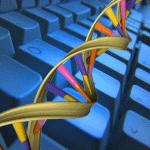Bioinformatics
|
8 april 2014 12:03:03 |
| Phenotypic comparisons of consensus variants versus laboratory resurrections of Precambrian proteins (Proteins: Structure, Function, and Bioinformatics) |
|
Tweet Consensus-sequence engineering has generated protein variants with enhanced stability, and sometimes, with modulated biological function. Consensus mutations are often interpreted as the introduction of ancestral amino acid residues. However, the precise relationship between consensus engineering and ancestral protein resurrection is not fully understood. Here, we report the properties of proteins encoded by consensus sequences derived from a multiple sequence alignment of extant, class A ?-lactamases, as compared to the properties of ancient Precambrian ?-lactamases resurrected in the laboratory. These comparisons considered primary sequence, secondary and tertiary structure, as well as stability and catalysis against different antibiotics. Out of the three consensus variants generated, one could not be expressed and purified (likely due to misfolding and/or low stability) and only one displayed substantial stability having substrate promiscuity, although to a lower extent than ancient ?-lactamases. These results: i) highlight the phenotypic differences between consensus variants and laboratory resurrections of ancestral proteins; ii) question interpretations of consensus proteins as phenotypic proxies of ancestral proteins; and iii) support the notion that ancient proteins provide a robust approach towards the preparation of protein variants having large numbers of mutational changes while possessing unique biomolecular properties. © Proteins 2014;. © 2014 Wiley Periodicals, Inc. |
| 89 viewsCategory: Biochemistry, Bioinformatics |
 Multiple conformational states and gate opening of outer membrane protein TolC revealed by MD simulations (Proteins: Structure, Function, and Bioinformatics) Multiple conformational states and gate opening of outer membrane protein TolC revealed by MD simulations (Proteins: Structure, Function, and Bioinformatics)Assessment of fully automated antibody homology modeling protocols in MOE (Proteins: Structure, Function, and Bioinformatics) 
|
| blog comments powered by Disqus |
MyJournals.org
The latest issues of all your favorite science journals on one page
The latest issues of all your favorite science journals on one page



